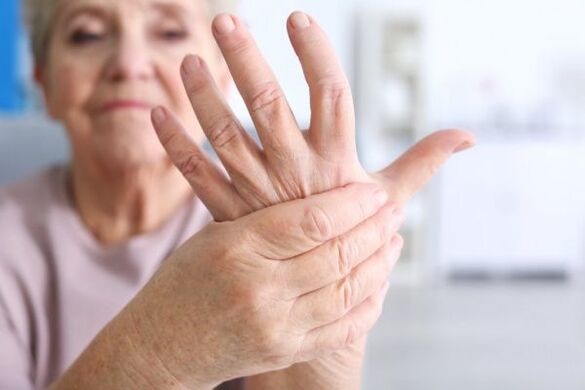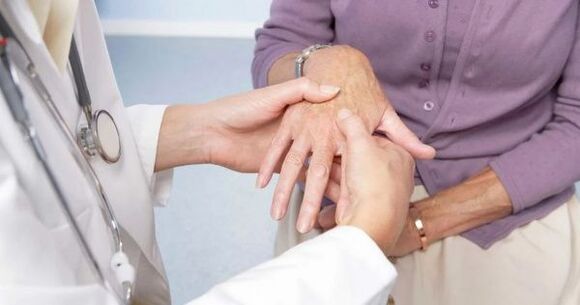
finger painIt occurs when the bones, joints, soft tissues, blood vessels, and nerves are affected. It can be dull, sharp, weak, intense, constant, intermittent, of short duration. There is often a connection with motor activity, weather conditions, and other factors. Concomitant external disturbances are possible: deformations, changes in color and temperature, edema. To determine the cause of pain in the fingers, the results of a survey, an external examination, an X-ray examination and other methods are used. Until the diagnosis is made, rest is recommended, sometimes taking pain relievers.
Why do fingers hurt?
traumatic injuries
A finger injury is characterized by moderate pain. Then the intensity of the pain gradually decreases. Edema, hyperemia, cyanosis, hemorrhages are possible. Finger function is slightly impaired. Hematomas on the palmar surface of the fingers are manifested by moderate pain, detachment of the skin with the formation of a cavity filled with dark blood. With subungual hematomas, the pain is intense, spasmodic, throbbing and is aggravated by lowering the brush. Partial or complete detachment of the nail plate is possible.
A broken finger is accompanied by intense, explosive pain at the time of injury. Later, the pain subsides a little, but is still intense. The finger turns blue, swells, its functions are seriously violated. Deformities, crepitus, pathological mobility can be detected. When a finger is dislocated, a sharp pain is felt. The finger is deformed, swollen, trying to move in the affected joint, the strength of the spring is determined.
With frostbite in the first hours, the pain is mild, with tingling. Then the pain syndrome intensifies, acquires a burning character. The finger swells, becomes cyanotic. With deep frostbite, there is no sensitivity in the distal parts, the fingers are cold, pale, the pain bothers at the border between healthy and affected tissues.
infectious lesions
Panaritium is characterized by rapidly increasing pain, swelling, hyperemia, cyanosis, abscess formation. Spasmodic, throbbing pains, which deprive the night of sleep. Especially strong painful sensations are expressed with subungual panaritium and deep forms of the disease (bone, articular, tendon). With superficial forms of panaritium (cutaneous, periungual, subcutaneous, subungual), the general condition suffers slightly, with deep symptoms of intoxication, fever.
Chinga develops in people involved in cutting and processing the carcasses of marine game animals, it presents with minor injuries: abrasions, wounds, cracks. It manifests itself as dull, weak pain in the wound area, which after 1-2 days is replaced by pain in the finger joint (usually the proximal one). The pain grows, becomes aching, throbbing, supplemented by swelling, pallor, cyanosis of the finger.
Arthritis
Pain in the joints of the fingers in rheumatoid arthritis is symmetrical. 1 degree of activity is manifested by minor arthralgias, with the rigidity quickly disappearing. In grade 2, the pain is disturbed at rest and during movement, combined with prolonged stiffness, limitation of movement, redness. Grade 3 is characterized by constant severe pain, persistent stiffness, swelling, hyperemia. Movement is severely limited.
Gouty arthritis of the fingers is more common in women. One or more joints may be affected. The pain is usually sharp, stabbing, combined with edema, hyperemia, impaired function and increased general temperature. Erased symptoms are observed less often: mild pain and mild redness with a satisfactory general condition.
Psoriatic arthritis occurs suddenly or gradually. In the first case, the pain is moderate, increasing, in the second - sharp, intense. At the height of the disease, the typical picture includes soreness, aggravated at night and at rest, weakening during the day, with movements, swelling of the fingers, bluish-purple discoloration of the skin. The distal interphalangeal joints are the most affected. Over time, multiple deformations appear.
In post-traumatic arthritis, a joint is affected. For infectious allergic forms of the disease, which develop against the background of bacterial and viral infections, multiple lesions are typical. With professional peripheral arthritis, the most loaded joints of the fingers are involved in the process. The pain in all the listed forms of pathology intensifies at night, weakens during the day and is supplemented by morning stiffness, local swelling and difficulty moving. With a long course, deformations are noted.

degenerative pathologies
With arthrosis of the hands, the pain is initially indefinite, periodic, of short duration. There is morning stiffness. Subsequently, the painful sensations intensify, are prolonged, sometimes burn, are noticeable with any movement, limit daily activity and perform delicate operations. Heberden and Bouchard nodes are formed. Lateral deformations are formed.
Ligament and tendon diseases
Patients suffering from stenosing ligamentitis are concerned about pain along the palmar surface at the base of the affected finger. At first, the pain syndrome appears only with pressure and small movements, then it remains at rest. Movements are limited, accompanied by a click. Over time, a flexion contracture develops, after a click, pain in the arm occurs.
In the initial stage, De Quervain's disease is manifested by pain during abduction, hyperextension of the first finger. Subsequently, aching and pressing pains occur with any physical activity, some patients bother even at rest. Typical radiation to the distal phalanx or forearm from the side of the big toe.
angiotrophoneurosis
Raynaud's syndrome is caused by vasospasm, accompanied by paroxysmal numbness, cold fingers. The pain occurs in the second phase of the attack, has a brittle character, is combined with a burning sensation, fullness. Pain syndrome is short-term, replaced by a feeling of heat, redness of the distal parts of the hands. Pathology occurs in a variety of diseases of various origins, including:
- Rheumatoid arthritis;
- systemic lupus erythematosus;
- scleroderma;
- Sharp syndrome;
- antisynthetase syndrome;
- thromboangiitis obliterans of the upper extremities;
- endocrine, metabolic, occupational pathologies.
In the absence of other diseases that provoke this condition, they speak of Raynaud's disease with a similar pain syndrome. This form is more common in women.
Erythromelalgia occurs independently or is formed in patients with endocrine, neurological and hematological diseases. It is manifested by paroxysmal attacks of baking, burning pain, edema, hyperemia of the fingers. The pain may spread from one limb to another or may occur simultaneously in the region of both limbs. The pain attacks are so intense that they interfere with any movement. The pain decreases when cooling and raising the hand, increases when warming and lowering the hands.
neurological pathologies
Pain in the fingers occurs when the nerves are damaged, spreads in the zone of innervation, has a stabbing or burning character, is supplemented by sensory disturbances, autonomic-trophic disorders. Possible neurological causes:
- Neuropathy of the median nerve.The pain is localized on the palmar side of the I-III fingers, combined with the inability to bend the fingers, clench the hand into a fist, oppose the I finger.
- carpal tunnel syndrome.A type of median nerve neuropathy caused by compression of nerve fibers at the wrist level. Localization of pain - as in the previous case. Typical nocturnal attacks, decrease in pain when lowering the arms, shaking the brushes.
- Radial nerve neuropathy.With an injury at the level of the forearm and wrist, pain is noted along the back surface of the first finger and hand, sometimes extending to the second and third fingers. Irradiation to the forearm, numbness of the back of the hand are characteristic.
- Neuropathy of the ulnar nerve.The pain is localized mainly in the area of the elbow joint, but can radiate to the hand, fingers IV-V. The pain syndrome often intensifies in the morning.
tumors
Benign tumors involving the finger bones include chondromas and osteoid osteomas. Chondromas are manifested by non-intense pain sensations with indistinct localization, osteoid osteomas, by sharp pains in the affected area. Malignant neoplasm of the fingers is rare.
Other reasons
Pain in the fingers and hand is observed in patients with writing spasm, which develops with occupational neurosis, some other mental and neurological disorders. Pain occurs when typing, working at a computer or typewriter. They are breaking, pulling, supplemented by tremors, sudden weakness of the hand, local convulsions. Also, pain in the fingers can be detected in the following pathologies:
- Leukemia: Waldenström's macroglobulinemia.
- Adrenal gland tumors: aldosteroma.
- diabetes complications: diabetic neuropathy.
- vascular diseases: distal digital embolism due to occlusion of the subclavian artery.
- hereditary diseases: Fabry disease.
- childhood diseases: neuroarthritic diathesis.
Diagnosis
Traumatologists-orthopedists are engaged in establishing the causes of pain in the fingers. The diagnosis is made on the basis of a conversation with the patient, data from external examinations, additional studies. The diagnostic program includes:
- Poll. The doctor finds out when and under what circumstances the pain syndrome and other symptoms first appeared, determines the features of the dynamics of the development of the disease, the factors that provoke an improvement or deterioration in the patient's condition. Study life history, family history.
- Physical exam. The specialist evaluates the appearance of the fingers, reveals deformities, inflammation, cracks, dry skin, changes in temperature and color, swelling and other manifestations of the pathology. She checks for sensation, range of motion, pulsation in the peripheral arteries.
- Bone scan.It is performed in two projections with the taking of the affected fingers or the whole hand. Confirms the presence of fractures, dislocations, tumors, inflammatory and degenerative processes, areas of destruction of solid structures in the form of deep panaritium.
- Electrophysiological studies.They are performed for pain of neurological origin to clarify the level of nerve damage, assess the condition of the muscles and nerve conduction.
- Lab tests. Produced to determine inflammation, assess the general condition of the body, detect specific markers in collagenosis.
According to indications, patients are referred for consultation with an endocrinologist, neurologist, vascular surgeon, and other specialists. Assign CT, MRI, other instrumental techniques. Perform a biopsy of hard and soft structures for cytological or histological examination.

Treatment
First aid
In case of traumatic injuries, a cool and elevated position of the extremity is recommended. The hand is fixed with a splint or improvised materials (for example, planks). The brush is lifted or a scarf is worn. With a severe pain syndrome, an analgesic is administered, in the absence of external damage, chloroethyl is applied.
Help for diseases is determined by the nature of the pathology: a change in the position of the limb, heating, or, on the contrary, cooling, can help. The most common measure is rest, however, in some diseases (carpal tunnel syndrome, arthritis), the pain syndrome decreases while maintaining motor activity. Sharp spasm pains, pronounced signs of inflammation, general hyperthermia are the reason for an urgent consultation with a specialist.
conservative therapy
In case of dislocations and fractures, local anesthesia is performed, reduction is performed and a plaster is applied. Conservative treatment of traumatic and non-traumatic pathologies of the fingers involves the following activities:
- protection mode. It is selected taking into account the nature and severity of the disease. Possible recommendations for load limitation, the use of orthopedic devices, the imposition of a cast.
- medical therapy. Non-steroidal anti-inflammatory drugs, antibiotics, drugs to improve blood circulation, neurotropic drugs are used. According to the indications, corticosteroid blocks are performed.
- Non-pharmacological methods. Exercise therapy, massage, physiotherapy, manual therapy, kinesiotaping are prescribed.
Surgical interventions
Operations are performed when conservative methods are ineffective, to reduce time and improve long-term treatment results. Taking into account the characteristics of the injury, the following is done:
- injuries: fixation of fractures and dislocations with knitting needles, necrectomy and amputation of fingers in case of frostbite.
- Infectious diseases: opening, drainage of panaritium, in case of serious injuries in some cases - amputation or disarticulation.
- Tendon and ligament diseases: dissection of the dorsal ligament and excision of adhesions in de Quervain's disease, dissection of the annular ligaments in stenosing ligamentitis.
- Neoplasms: removal of neoplasm, bone resection.
- Neurological diseases: nerve decompression.
After surgery, antibiotic therapy is prescribed. Patients undergo comprehensive rehabilitation aimed at maximizing restoration of hand function.



















